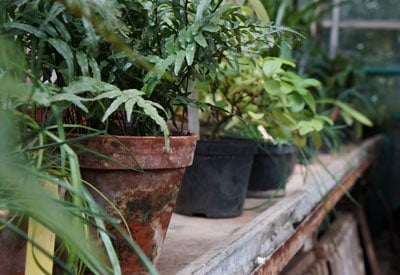Friends that read this blog are always anxious to offer criticism, point out mistakes, and otherwise find things I’ve said that just might not be true in every case. Rather than get all defensive, we’ve learned to engage our fact-checkers, address the questions and, more often than not, learn something in the process.
So when a couple of longtime gardeners began taking exception to some of the things I said in “Winter Protection for Potted Plants,” I paid attention. Much of what they commented on wasn’t about out-and-out mistakes. Most of the corrections and considerations my friends made were of the “not true in every case,” and “you failed to make the distinction,” and, best (or worst, depending on your point of view) “you promised the moon” sort. So let’s start with the moon.

GROW LIGHT KIT
DaySpot (60W)
This full spectrum 60W powerhouse will produce healthier plants and blooms.
Learn moreAt Planet Natural, we’ve carefully selected only the best indoor gardening supplies — from lighting and hydroponics to growing mediums — to make your indoor growing experiences blossom.
Overwintering plants is an imperfect art. Success is relevant to the conditions and, let’s face it, most seasons present a day or three of special conditions. In general, conditions are changing. It’s not unusual to lose plants that you bring indoors; in fact, it should be expected. Success, measured when those plants are taken back outside and then thrive, is an achievement and should be celebrated. Failure is the way you learn to be successful.
A couple friends lucky enough to have greenhouses said that I over-emphasized their abilities. Greenhouses, especially free-standing greenhouses, are prone to wide temperature swings. A sunny day can raise temps well above outdoor temperatures. Insulating the pots with plants you keep in your greenhouse will moderate the temperature swings in the soil but not in the air. Bottom line: make sure you monitor greenhouse temperatures. This may mean venting on a sunny day in February. It also means choosing to overwinter only plants that can take some temperature extremes.
To help keep night time temperature up, you’ll want to conserve the solar gain you’ve made during the day. One acquaintance of mine uses stones inside his greenhouse, a row lining the sides and a stack he works around in the center. These stones — each requires two hands to lift — warm during the daylight hours and release their heat slowly back into the greenhouse during the evening. Any dense material — concrete, water barrels (with water), even soil in the pots — serves the same purpose. My friend claims that his stones also slow the quick warming of his greenhouse come daylight but I think that’s probably not true enough to be effective.
A more useful criticism came from a friend who pointed out that the conditions in garages and basements aren’t consistent. A basement in Montana may be much cooler than one in the warmer climes of New Mexico. But that basement in Montana may have good southern exposure to sunlight near its small windows that certain plants will love. So consider the micro-climate of the place you choose to overwinter plants. Your garage may have windows and abundant (but short-lived) sunlight during the day. Or it may have no sunlight at all. Sunlight and temperature are the two most important things to consider.

If you’re bringing a potted plant indoors for the first time and aren’t sure what conditions they’ll survive, give them the best. For me, this has meant bringing them into the kitchen or dining room close to a south, east or west facing window. Water moderately — let the soil dry out completely before you do — and give the plants a quarter turn each week to evenly distribute light. Trimming plants back when first brought in can also be beneficial. With less mass to support the plant stands a better chance. Don’t feed them while indoors — orchids are the exception.
Know your plants. Some plants, like calla lilies and dahlias do best in a cool dark place. Some, like agave plants, like cool places but plenty of light. Some, like geraniums, need moist conditions. And some, like begonias and decorative sages, need warmth and light. Because winter days are short and don’t always offer enough sunlight to keep plants healthy, we (and my critical friends) can’t recommend grow lights enough for the plants that require brightness. These can be simple, T5 fluorescent fixtures, or bright spots specifically designed for sun-loving plants. Either way, lights can add warmth and interest to your indoor setting, as they highlight the plants they’re sustaining.
Here’s specific advice on overwinter exotics and other landscape plants. What plants do you overwinter indoors, and how do you do it? We want to know.











